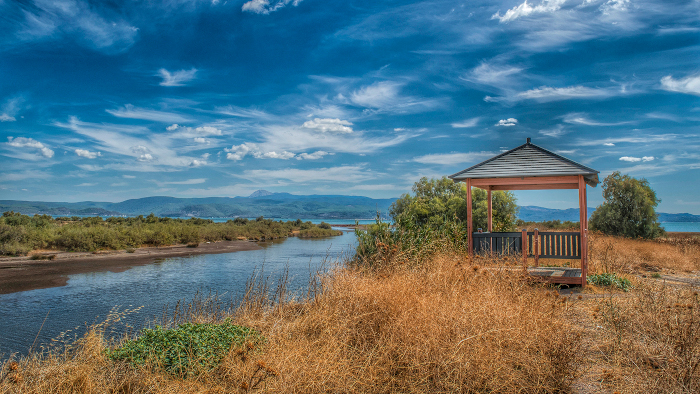One of the oldest cities in the Greek area, inhabited in the same location since its foundation, is Mytilini. Its original location was on the small island, where the castle and its foundation are placed in 1183 BC, a few years after the fall of Troy. Until the first Byzantine centuries, the area was formed by a small island, separated from Lesbos by a channel, 700 m long and 30 m wide, called "Euripos of Mytilene". This is today's Ermou Street. It connected the two major ports of the city, the northern one of Epano Skala and the southern one. Thus, crossing the canal, ships could sail in any weather, north or south. The current residential fabric of the city has spread quite along the beach and is surrounded by seven low hills. The developments of the defense technique of the cities, they formed over the centuries the final form of the castle, as it appears dominating over the settlement. It is probable that the first building was erected during the reign of Emperor Justinian, in the 6th AD. h. Identified with the life of the city, it was the largest in the Mediterranean area, with underground chambers and arcades, water tanks and successive rows of high walls. The pine forest that is currently located on its southern side was planted in 1916 by the National Defense troops of El. Venizelou, when the castle as a building had lost all sense of strategic importance. A few years later, until 1940, all use of it stopped. Identified with the life of the city, it was the largest in the Mediterranean area, with underground chambers and arcades, water tanks and successive rows of high walls. The pine forest that is currently located on its southern side was planted in 1916 by the National Defense troops of El. Venizelou, when the castle as a building had lost all sense of strategic importance. A few years later, until 1940, all use of it stopped. Identified with the life of the city, it was the largest in the Mediterranean area, with underground chambers and arcades, water tanks and successive rows of high walls. The pine forest that is currently located on its southern side was planted in 1916 by the National Defense troops of El. Venizelou, when the castle as a building had lost all sense of strategic importance. A few years later, until 1940, all use of it stopped.
In the Prehistoric era it had many names such as Lasia, Imerti, Pelasgia, Issa, etc. In mythology it is mentioned that its first settler was Makaras son of Helios, the most famous of the mythical kings who had five daughters: Mytilene, Mithymna, Issa, Antissa and Arisvi, as well as four sons: Heresos , Cydrolaos, Neandros and Leucippus.
Makara's daughters and sons gave their names to the main cities of Lesbos, which still exist today! Its current name "Lesvos" comes from Lesbos, son of the Thessalian hero Lapithos, husband of Mithymna.
The path of Lesvos through history is important and impressive, just like many cities and regions of Greece. The archaeological findings testify that a civilization similar to the Mycenaean developed on the island, which was destroyed and the island deserted after the flood of Deucalion in 1529 BC.
In 1507 BC the Pelasgians come and in 1393-1184 BC. it is inhabited by the Achaeans.
In 1000 BC the Aeolian colony of the Penthylides is founded on Lesbos, which grows and flourishes, expanding its settlement activity to the opposite coast of Asia Minor, which took the name "Mytilene Aegialos". In this area, near the tomb of Achilles, the Mytileneans built the city of Achillio.
In the middle of the 7th century BC. they expand throughout the Troas and become a powerful naval force.
They ally themselves with the Athenians, then the Spartans, are severely punished by the Athenians, and follow the same path as other ancient Greek cities: rise, fall.
Afterwards, the Romans, the Byzantines, the Crusaders, the Saracens, the Latins were from time to time conquerors of the island, which some plundered and others liberated.
On October 14, 1462, the Turks came and plundered and slaughtered all 100,000 inhabitants, leaving only thirty thousand on the island.
Lesvos was liberated in December 1912 and its full integration with Greece took place in 1914.
The island witnessed one more occupation during the Second World War, when the German army occupied it in 1941. The occupation lasted until 1944.
Throughout its long history, Lesbos presents timeless spiritual figures: Terpandros ( 700 BC), creator of lyric poetry, Pittacus (648 BC), one of the seven wise men of antiquity, Arion (625 BC), charismatic lyric poet and guitar player, Alkaios ( 600 BC), also a prominent lyric poet, and Sappho (620 BC), the greatest poetess of antiquity, whose poems are distinguished by their passion and sensibility, which justly earned her the title " Tenth Muse".
Other important personalities of antiquity are Theophrastus (372 BC), an excellent philosopher and botanist - also known as the "father" of Botany and Theophanes (100 BC), an important historian and follower of Pompey in his campaigns in Asia Minor.
Editor: Fotini Anastasopoulou
